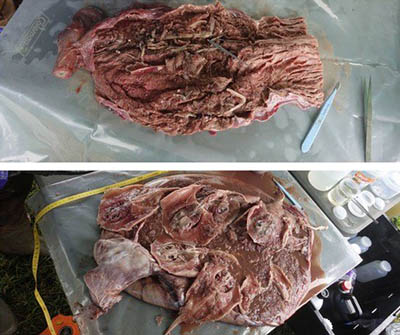What are in shark guts? And what can the contents tell us? The results can be confusing – as we find prey, within prey. To decipher this ‘Russian doll effect’, scientists from the University of Sydney, Australian Museum, and NSW Department of Primary Industries tell us more.
Anyone remember the scene in “Jaws” where Matt Hooper (played by Richard Dreyfuss) opens the tiger shark stomach? What spilled out was a milky white substance, whole fish, fish head, mangled tin can, and a Louisiana license plate. This is a neat trick of Hollywood fakery, but what rings true is that shark gut contents can be gloopy, grisly, and downright gruesome. Good luck to any researcher intent on identifying all the gut contents too, particularly those fishes or marine invertebrates digested beyond recognition. In our recent Scientific Reports study, we applied a new genetic tool that allowed us to sequence the DNA of all species present in the shark chyme, which is the semifluid mass of partially digested food.

In Australia, several shark species are targeted in commercial gillnet fisheries, such as gummy sharks (Mustelus antarcticus) and sandbar sharks (Carcharhinus plumbeus), but other species, such as bull sharks (Carcharhinus leucas), tiger sharks (Galeocerdo cuvier), and white sharks (Carcharodon carcharias), are targeted in bather-protection programs using gillnets or baited hooks on SMART drum lines. The NSW Government’s Shark Meshing Program has been controversial in recent decades owing to unwanted catches of non-target sharks (it was introduced as a public safety measure in 1937). But, it has protected 51 of the state’s most popular beaches from rare shark encounters, and provides valuable biodiversity data and biological material.
In our study, we took advantage of by-caught shark specimens sourced from NSW bather-protection fishing gear for two different species, the common blacktip shark (Carcharhinus limbatus) and the great hammerhead shark (Sphyrna mokarran). These two species are globally classified as Near Threatened and Critically Endangered, respectively by the International Union for Conservation of Nature. There is also little known about their ecology in Australian waters, particularly feeding behaviour and diet. These specimens therefore provided a rare opportunity to assess the diet of these two shark species by examining stomach contents from dead animals. Traditionally, only visual inspection of stomach contents has been used to determine diet, but this biases composition towards intact or recently consumed prey that is easily identified based on preserved hard parts (e.g., bones, spines, or scales). Here we heralded in the power of DNA amplification by simply blending up the stomach contents of sharks, and in select cases, the stomach contents of its intact prey (i.e., round rays and shovelnose rays). By matching the resultant DNA sequences from this stomach chyme to public genetic databases we could figure out exactly what they had both been eating. Shark stomach smoothie anyone?
Notwithstanding the important results above, our DNA analyses showed there was extensive intermixing of prey DNA between predator and prey stomachs, which limited the opportunity to clearly define the primary predator of some food items. Such intermixing of predator and prey stomach contents means the Russian-doll approach requires further investigation in DNA studies focused on dietary preferences, and ongoing reliance on traditional methods for visually confirming diets.
This story was originally published on the blog of the Australian Museum Research Institute.
Dr Mark de Bruyn, Senior Lecturer in Evolutionary Biology, School of Life and Environmental Sciences, University of Sydney.
Dr Joseph DiBattista, Curator Ichthyology, Australian Museum.
Dr Matt Broadhurst, Senior Research Scientist, NSW Department of Primary Industries.
Reference
de Bruyn M, Barbato M, DiBattista JD, Broadhurst MK (2021) Secondary predation constrains DNA-based diet reconstruction in two threatened shark species. Scientific Reports 11: 18350.